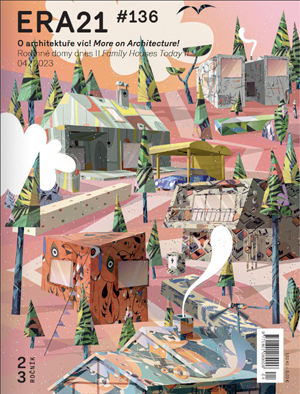The strong local glassmaking tradition is reflected both in the work and design by Lasvit and in the architecture. Joining all the buildings together into one functional unit, the new design brings a contemporary interpretation of the typical two‑story glass maker's house. Two new abstractly shaped volumes with rectangular plans and gabled roofs were added next to the original protected 19th century houses. The glass building replaces a corridor that used to connect both historical houses, inside there is an office café, conference room, and sample library. The black building, at the back of the site, contains a three-story open space for the testing and presentation of 1:1 samples, glass objects which can weigh up to five tons.
» entire articleWater has gradually disappeared from the Czech landscape over the course of the 20th century. The demands of industrial society and the ideas of unlimited progress and control of nature have water entrapped in the infrastructural networks. Streams and rivers have turned into distribution channels, reinforced and straightened, and water in large reservoirs has been used to feed the growth of national economy. It’s important to appreciate, however, that this process wasn’t a result of engineering ignorance or destructive political ideology. The efforts to control water, which led to the changes of the water regime in Czechia in the 20th century, were based on a general societal consensus.
» entire articleTéma klimatické změny rezonuje naší společností čím dál silněji a lze říci, že se týká téměř všech oborů lidské činnosti, architekturu nevyjímaje. Proto architekti Jan Soukup a Marek Dohelský zformulovali Deklaraci 2020,1 kterou vyzývají ke vzájemné spolupráci a veřejné debatě nad problematikou klimatické změny v kontextu našeho oboru. K výzvě se může připojit kdokoli svým podpisem.
» entire articlePřestože se v současnosti věnuje velká pozornost inteligentním systémům pro rodinné domy (ovládání stínění, osvětlení, přístupu do domu ad.), nalezne takové centrální řízení samozřejmě uplatnění i u větších občanských či komerčních staveb. Právě jejich koordinaci se ve společnosti Somfy, specializující se zejména na pohony a ovládání stínění, věnuje projektový manažer Tomáš Veselý.
» entire articleWhile a small and feisty Swedish schoolgirl sails across the Atlantic to scold the American president, those climate and climate-related issues she’s concerned with are becoming an important topic locally, here in Czechia. A friend of mine, an IT specialist, recently asked me what he, as a passive owner of some agricultural land inherited from his ancestors and returned to him in restitution, could do to fight drought. I was surprised. For me as an expert, the disappearance of water from the landscape has been an issue for a long time. I got used to regular floods, to the permanent degradation of a large portion of Czech fields by erosion. I added drought to this list of challenges I had to get used to in the last couple of years...
» entire article

ERA21 vydává ERA Média, s. r. o. |
|
|
Phone: +420 530 500 801 E-mail: redakce@era21.cz |
|
| WEBdesign Kangaroo group, a.s. |